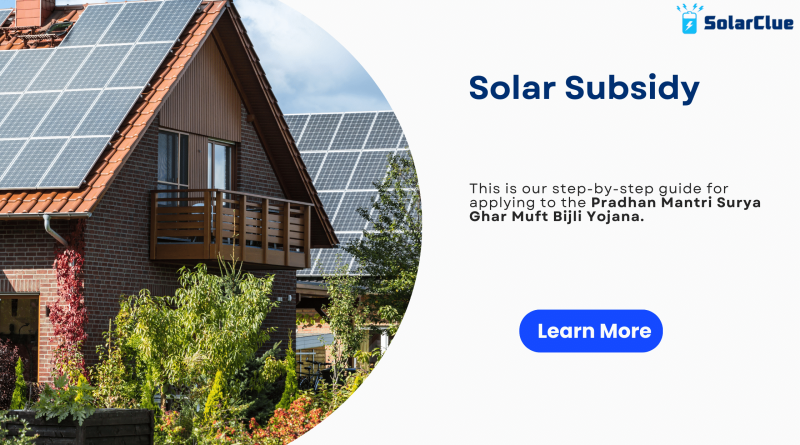Step-by-Step Guide: Applying for Solar Subsidy in India
India has made huge progress in renewable energy, as witnessed by the Pradhan Mantri Surya Ghar Muft Bijli Yojana. Through this program, homes will get subsidies for installing solar panels, increasing the affordability and accessibility of sustainable energy. In 2024, if you plan to apply for Solar Subsidy, make sure you follow our step by step guidance for Smooth and Quick application process.
Table of Contents
- 1 Step 1: Understand the Pradhan Mantri Surya Ghar Muft Bijli Yojana
- 1.1 Step 5: Request for Quotation from the Vendors
- 1.1.1 Step 9: Request for Inspection and Commissioning
- 1.1.2 1. How much subsidy is provided under the Pradhan Mantri Surya Ghar Muft Bijli Yojana?
- 1.1.3 2. Can I apply for the subsidy if I live in a rented property?
- 1.1.4 3. What are the maintenance costs for solar panels?
- 1.1.5 4. Is there any loan available for the initial investment?
- 1.1.6 5. How long does it take to recover the investment?
- 1.1 Step 5: Request for Quotation from the Vendors
What is PM Surya Ghar Muft Bijli Yojana?
PM Surya Ghar Muft Bijli Yojana is a Central Scheme that aims to encourage people to opt for installation of solar roof tops system. The individuals will get subsidy on installation of solar rooftop system on there houses. Each month, homeowners will be able to generate 300 units of free power on an average and the excess power can be exported back to grid. The individuals will be paid for the excess power generated.
Steps for Applying to Solar Subsidy in India
Let us discuss about step by step guide for applying to solar subsidy in india.
Step 1: Understand the Pradhan Mantri Surya Ghar Muft Bijli Yojana
Before getting into the application process, it’s very important to understand what the Pradhan Mantri Surya Ghar Muft Bijli Yojana is about?This scheme aims to encourage people to install solar panels on rooftop of there houses and give solar subsidy on it, by this people can reduce electricity bills and promote sustainable energy. The subsidy covers certain portion of the installation costs, making it less burden on homeowners.
Step 2: Check for Solar Subsidy Eligibility
Eligibility criteria for the subsidy include:
- Residential Status: Only residential houses are eligible. Commercial or industrial properties do not qualify.
- Location: The scheme is available across India, but in certain states may have additional benefits or requirements.
- Documentation: You need have proof of ownership of the property and be willing to provide necessary documents such as Aadhaar Card, property tax receipts, and electricity bills.
Step 3: Select a Registered Vendor From the Portal
The government has a list of Registered vendors and installers for the scheme. Make sure to select a vendor from this list to be eligible for the subsidy. Approved vendors are listed on the official website or the specific portal for the Pradhan Mantri Surya Ghar Muft Bijli Yojana.
Step 4: Apply for Site Assesment
Once you have chosen a vendor, they will conduct a site assessment to for smooth installation of solar panels on your property. This assessment includes:
- Roof Condition: Checking if your roof can support the panels.
- Sunlight Exposure: Checking the amount of sunlight your roof receives.
- Space Availability: Analysing there is enough space for the panels.
Step 5: Request for Quotation from the Vendors
Based on the site assessment, the vendor will provide a quotation. This quotation will include the total cost of installation, the subsidy amount, and the net amount payable by you. Check this quotation carefully and ask questions if you have any doubts.
Step 6: Apply for Solar Subsidy on the Portal
To apply for the subsidy, follow these steps:
- Visit the Official Portal: Go to the official website for the Pradhan Mantri Surya Ghar Muft Bijli Yojana.
- Register: Create an account or log in if you already have one.
- Fill in the Application Form: Complete the online application form with correct details about yourself and your home.
- Upload Documents: Submit scanned copies of required documents such as Aadhaar Card, property ownership proof, electricity bill, and the vendor’s quotation.
- Submit the Application: After filling all the details and uploading documents, submit your application.
Step 7: Wait for Approval of the Solar Subsidy Scheme on Portal
After submitting your application, it will be reviewed by the authorities. This process may take a few weeks. You will receive a message once your application is approved. Keep an eye on your registered email and phone number for updates.
Step 8: Installation of Solar Panels
Once the application is approved, the vendor will schedule the installation of the solar panels at your home. The installation process includes:
- Mounting the Panels: Installing the solar panels on your roof.
- Connecting to the Inverter: Connecting the panels to an inverter which converts solar energy into electricity.
- Wiring and Testing: Completing the electrical wiring and testing the system to ensure it’s working correctly.
Step 9: Request for Inspection and Commissioning
After installation, an inspection will done to ensure that the system is installed correctly and is operational. This inspection is usually done by a person from the government or the approved vendor.
Step 10: Experience Your Solar-Powered Home
Once the inspection is complete and your system is commissioned, you can start enjoying the benefits of solar power. Monitor your electricity bills to see the savings and feel good about contributing to a greener planet.
Step 11: Maintenance and Monitoring
Once your solar panel system is up and running, maintaining it is very important so that it performs better. Here are some tips for maintaining your solar system:
- Regular Cleaning: Dust and debris can stick on the panels and will reduce efficiency. Clean the panels on regular basis with water and a soft cloth or hire a professional cleaning service.
- Monitor Performance: Most solar systems come with a monitoring app. Use it to track energy production and identify any issues.
- Annual Inspections: Schedule an annual inspection with your vendor to check for any wear and tear or technical issues.
Conclusion
The Pradhan Mantri Surya Ghar Muft Bijli Yojana is a initiative that brings the benefits of solar energy to homeowners across India. By following this step by step guide, you can successfully apply for the Solar Subsidy and enjoy the long-term benefits of reduced electricity bills and a less carbon emission. Remember to stay updated regaring any changes to the scheme by regularly checking official website. contribute to a sustainable future for yourself and the planet.
Frequently Asked Questions (FAQs)
1. How much subsidy is provided under the Pradhan Mantri Surya Ghar Muft Bijli Yojana?
The subsidy amount can vary based on the size of the solar installation and other factors. Generally, the government offers a subsidy of up to 40% for rooftop solar systems up to 3 kW and up to 20% for systems between 3 kW to 10 kW.
2. Can I apply for the subsidy if I live in a rented property?
No, only property owners can apply for the subsidy. If you are a tenant, you will need to speak with the house owner to consider this option.
3. What are the maintenance costs for solar panels?
Maintenance costs for solar panels are low. Regular cleaning and professional inspections are usually fine to keep the system running smoothly. The panels typically come with a warranty of 20-25 years.
4. Is there any loan available for the initial investment?
Yes, Many banks and financial institutions offer loans specifically for solar installations. These loans often come with favorable terms and interest rates. Additionally, some vendors might offer loan options.
5. How long does it take to recover the investment?
The payback period for a solar installation can recover with in 5 to 7 years, depending on things like system size, local electricity rates, and the amount of sunlight your location receives.




